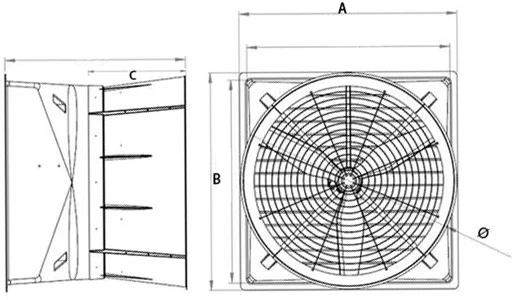cooling pad for evaporative cooler
Nov . 12, 2024 15:18 Back to list
cooling pad for evaporative cooler
The Role of Cooling Pads in Evaporative Coolers
Evaporative coolers, commonly known as swamp coolers, are a popular choice for providing an efficient and environmentally friendly cooling solution, especially in dry and arid climates. These devices leverage the natural process of evaporation to lower air temperature, making them a cost-effective alternative to traditional air conditioning systems. A critical component of evaporative coolers is the cooling pad, which plays a significant role in maximizing their performance. This article explores the functionality, types, benefits, and maintenance of cooling pads for evaporative coolers.
Understanding Cooling Pads
Cooling pads are designed to absorb water and increase the surface area for evaporation. When warm air passes through these pads, the moisture evaporates, absorbing heat from the air, thus reducing its temperature. The efficiency of this process depends significantly on the material and design of the cooling pads. They are typically made from cellulose, aspen, or synthetic materials that have high water retention capabilities.
Types of Cooling Pads
1. Cellulose Pads Made from treated paper or cardboard, cellulose pads provide excellent evaporation rates. They are highly absorbent, which enhances their cooling efficiency. The structure of these pads allows for better airflow, leading to improved performance.
2. Aspen Pads These are made from aspen wood fibers and are known for their natural characteristics that aid in cooling. Aspen pads tend to be less efficient than cellulose pads but are often used for residential evaporative coolers due to their lower cost and ease of installation.
3. Synthetic Pads Made from plastic or polyester, synthetic pads are designed to last longer and are often more durable than natural materials. They resist mold and mildew, making them a suitable choice for areas with high humidity.
Benefits of Cooling Pads
1. Energy Efficiency One of the most significant advantages of evaporative coolers with effective cooling pads is their energy efficiency. They consume significantly less electricity compared to traditional air conditioning systems, leading to lower utility bills.
cooling pad for evaporative cooler

2. Cost-Effectiveness Cooling pads are relatively inexpensive compared to other cooling technologies. Replacement pads, especially cellulose and aspen types, usually have a manageable cost, making them an economical choice for homeowners.
3. Environmental Impact Evaporative coolers are generally more environmentally friendly since they use water instead of refrigerants to cool the air. Utilizing cooling pads helps in minimizing the carbon footprint associated with cooling systems.
4. Improved Air Quality Because evaporative coolers continuously circulate fresh air, they can enhance indoor air quality. The addition of moisture from the cooling pads also helps in maintaining comfortable humidity levels, reducing dryness in the air.
Maintenance of Cooling Pads
To ensure optimal performance of the evaporative cooler, regular maintenance of the cooling pads is essential. Here are some practices to consider
1. Cleaning Over time, cooling pads can accumulate mineral deposits and impurities, so they should be cleaned periodically. This can usually be done with a soft brush and water, ensuring that they are free from dust and debris.
2. Replacement Depending on the material, cooling pads may need to be replaced every few years. Cellulose pads typically last longer but should be inspected regularly for signs of wear or saturation that can inhibit performance.
3. Check for Mold and Mildew In humid climates, it’s crucial to monitor for mold or mildew growth. Regular thorough cleaning can help prevent this issue.
Conclusion
Cooling pads are integral to the performance of evaporative coolers, serving as the primary means of heat exchange and air cooling. By understanding the types of cooling pads available, their benefits, and proper maintenance practices, users can enhance the efficiency and lifespan of their evaporative cooling systems. This sustainable solution not only provides significant energy savings but also contributes positively to indoor air quality and overall environmental friendliness, making it a preferred choice for many homeowners. As temperatures continue to rise in many regions, the importance of efficient cooling solutions like evaporative coolers and their essential components cannot be overstated.
-
Hot Sale 24 & 18 Door Rabbit Cages - Premium Breeding Solutions
NewsJul.25,2025
-
Automatic Feeding Line System Pan Feeder Nipple Drinker - Anping County Yize Metal Products Co., Ltd.
NewsJul.21,2025
-
Automatic Feeding Line System Pan Feeder Nipple Drinker - Anping County Yize Metal Products Co., Ltd.
NewsJul.21,2025
-
Automatic Feeding Line System - Anping Yize | Precision & Nipple
NewsJul.21,2025
-
Automatic Feeding Line System - Anping Yize | Precision & Nipple
NewsJul.21,2025
-
Automatic Feeding Line System-Anping County Yize Metal Products Co., Ltd.|Efficient Feed Distribution&Customized Animal Farming Solutions
NewsJul.21,2025






